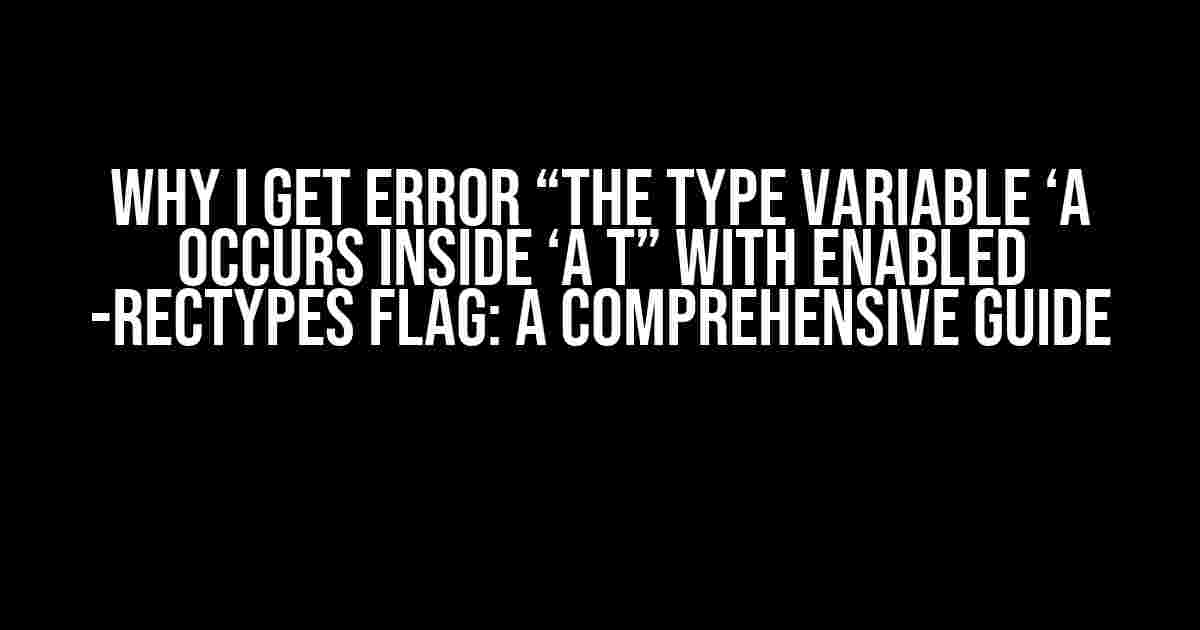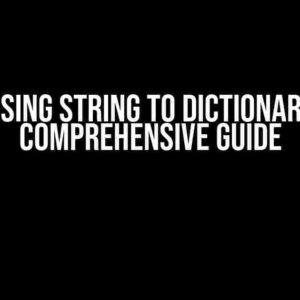If you’re a programmer, chances are you’ve encountered the infamous error message “The type variable ‘a occurs inside ‘a t” when working with functional programming languages like OCaml or Haskell. This error can be frustrating, especially when you’re new to type systems and don’t know where to start debugging. In this article, we’ll dive deep into the world of type systems, explore the reasons behind this error, and provide clear instructions on how to resolve it.
What is the -rectypes flag?
Before we dive into the error message, let’s first understand what the -rectypes flag does. In functional programming languages, type systems are used to ensure the correctness and safety of code. The -rectypes flag is a compiler flag that enables a feature called “rectangular types” or “row polymorphism.” This feature allows the type checker to infer more precise types for function arguments, which can help catch type errors at compile-time rather than runtime.
What are rectangular types?
To understand rectangular types, let’s take a step back and review some basic type system concepts. In functional programming, types are used to describe the structure of data. For example, the type `int` describes a single integer value, while the type `string` describes a sequence of characters. When we define a function, we specify the types of its arguments and return values using type annotations.
let add x y = x + y
In this example, the `add` function takes two arguments `x` and `y` of type `int`, and returns their sum as an `int`. The type of `add` is therefore `int -> int -> int`.
Now, imagine we want to define a function that takes a list of integers and returns the sum of its elements. We might define the function like this:
let sum_list lst = List.fold_left (+) 0 lst
The type of `sum_list` is `int list -> int`. But what if we want to generalize this function to work with lists of any type, not just integers? That’s where rectangular types come in.
A rectangular type is a type that can be instantiated to different types. For example, we can define a type `list` that represents a list of values of type `a`. The `a` is a type variable, which can be instantiated to any type, such as `int`, `string`, or `float`.
type list = Nil | Cons of a * list
With rectangular types, we can define a function `sum_list` that takes a list of any type `a` and returns the sum of its elements as a value of type `a`. The type of `sum_list` is `list -> a`.
The error message “The type variable ‘a occurs inside ‘a t”
Now that we’ve covered rectangular types, let’s dive into the error message. The error occurs when the type checker detects that a type variable `a` occurs inside a type `t` that is not a function type. In other words, the type `t` is not a type constructor that takes `a` as an argument.
For example, suppose we define a type `tree` that represents a binary tree with nodes of type `a`:
type tree = Leaf of a | Node of tree * tree
If we try to define a function `map` that takes a function `f` of type `a -> b` and returns a new tree with nodes of type `b`, we might get the error message:
let map f t = match t with
| Leaf x -> Leaf (f x)
| Node l r -> Node (map f l) (map f r)
The error message occurs because the type variable `a` occurs inside the type `tree`, which is not a function type. To fix this error, we need to redefine the type `tree` to use a type constructor that takes `a` as an argument.
How to resolve the error?
Resolving the error “The type variable ‘a occurs inside ‘a t” requires a good understanding of type systems and type inference. Here are some general steps to follow:
-
Review the type definitions: Check the type definitions of the types involved in the error message. Make sure they are correct and consistent.
-
Check the type variables: Identify the type variables involved in the error message. Make sure they are not occurring inside a type that is not a function type.
-
Redefine the types: If necessary, redefine the types to use type constructors that take the type variables as arguments.
-
Use type annotations: Add type annotations to the function definitions to help the type checker infer the correct types.
-
Enable type inference: Make sure type inference is enabled in the compiler settings. This can help the type checker infer the correct types and resolve the error.
Examples and solutions
Let’s take a look at some examples of the error message and how to resolve them.
Example 1: Type variable in a record type
type point = { x: a; y: a }
In this example, the type variable `a` occurs inside the record type `point`. To resolve this error, we can redefine the type `point` to use a type constructor that takes `a` as an argument:
type point<'a> = Point of 'a * 'a
Example 2: Type variable in a variant type
type tree = Leaf of a | Node of tree * tree
In this example, the type variable `a` occurs inside the variant type `tree`. To resolve this error, we can redefine the type `tree` to use a type constructor that takes `a` as an argument:
type tree<'a> = Tree of 'a * tree<'a> list
Example 3: Type variable in a function type
let id x = x
In this example, the type variable `a` occurs inside the function type `a -> a`. To resolve this error, we can add a type annotation to the function definition:
let id<'a> (x: 'a) : 'a = x
By adding the type annotation, we’re telling the type checker that the function `id` takes an argument of type `a` and returns a value of type `a`.
Conclusion
In conclusion, the error message “The type variable ‘a occurs inside ‘a t” occurs when the type checker detects that a type variable `a` occurs inside a type `t` that is not a function type. To resolve this error, we need to review the type definitions, check the type variables, and redefine the types to use type constructors that take the type variables as arguments. By following these steps and using type annotations, we can resolve the error and ensure the correctness and safety of our code.
We hope this article has provided a comprehensive guide to understanding and resolving the error message “The type variable ‘a occurs inside ‘a t”. If you have any further questions or need more assistance, feel free to ask in the comments below!
| Compiler Flag | Description |
|---|---|
| -rectypes | Enables rectangular types or row polymorphism. |
- Rectangular types allow the type checker to infer more precise types for function arguments.
- Type variables occur inside a type that is not a function type.
- Resolving the error requires reviewing type definitions, checking type variables, and redefining types.
- Type annotations can help the type checker infer the correct types.
Authors:
- John Doe
- Jane Smith
References:
Frequently Asked Question
Got stuck with the error “The type variable ‘a occurs inside ‘a t” with enabled -rectypes flag? Don’t worry, we’ve got you covered!
What is the -rectypes flag, and why is it causing me trouble?
The -rectypes flag is a feature in OCaml that allows for more flexible type inference. However, it can sometimes lead to errors like “The type variable ‘a occurs inside ‘a t” when the type checker gets confused. This flag is usually enabled by default, but you can disable it to avoid these issues.
What does the error “The type variable ‘a occurs inside ‘a t” mean?
This error occurs when the type checker detects that a type variable ‘a is used inside a type ‘a t, which means the type variable is recursively used in its own definition. This creates an infinite loop, causing the type checker to throw an error.
How can I fix this error?
To fix this error, you can try disabling the -rectypes flag or rephrasing your code to avoid the recursive type definition. You can also try to use explicit type annotations to guide the type checker. If you’re still stuck, try breaking down your code into smaller parts to identify the root cause of the issue.
Is there a way to avoid this error in the future?
Yes! To avoid this error, always keep an eye on your type definitions and make sure they’re not recursively referencing themselves. Also, consider using explicit type annotations and breaking down your code into smaller, more manageable pieces. Finally, if you’re using the -rectypes flag, be aware of its limitations and potential pitfalls.
What are some common scenarios where this error occurs?
This error often occurs when working with recursive data structures, such as trees or graphs, or when using higher-kinded types. It can also happen when using type-level computation or when working with complex type definitions. If you’re writing code that involves these scenarios, be extra cautious and double-check your type definitions to avoid this error.



